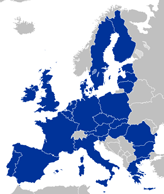Lung Malignancies the Leading Cancer-Related Cost in EU
Costs associated with cancer care vary widely between countries of the European Union, lung cancer represented the largest cost by individual malignancy, followed by breast and colorectal cancers.
Map of the European Union

Costs associated with cancer care vary widely between countries of the European Union, according to an analysis published in Lancet Oncology. Lung cancer represented the largest cost by individual malignancy, followed by breast and colorectal cancers.
“Cancer imposes a substantial economic burden on society,” wrote researchers led by Ramon Luengo-Fernandez, DPhil, of the Health Economics Research Centre at Oxford University in the United Kingdom. “The delivery of affordable cancer care systems requires public health and policy intelligence to incorporate a comprehensive estimation of the costs of cancer care.” His group evaluated costs across the 27 countries of the European Union in 2008, and included data on health care costs, informal care costs (meaning time lost for unpaid care), and productivity losses (ie, lost earnings after premature death).
They found the total economic cost of cancer in the European Union to be €126 billion in 2009, or $170 billion. The four most populous countries of the European Union, including Germany, France, Italy, and the United Kingdom, accounted for two-thirds of the total costs, and the seven countries with the lowest costs (Bulgaria, Cyprus, Estonia, Latvia, Lithuania, Luxembourg, and Malta) accounted for only 1% of the total.
When broken down, €51 billion ($69 billion) of the total went to direct health care costs; this was 4% of the total EU health care expenditures. There was substantial variation between countries on the specific costs of care: for example, 30% of cancer-related health care costs came from inpatient costs in Slovakia, and 67% was inpatient care in Ireland. Drug costs, which accounted for €13.5 billion ($18.1 billion) and 27% of health care costs, also varied widely from 15% in Lithuania to 61% in Cyprus. Across the European Union, the total cost was equivalent to €102 ($137) per person.
Lung cancer represented the highest overall cost when broken down by specific malignancy, at €18.8 billion ($25.3 billion, 15% of overall total); this was followed by breast cancer, colorectal cancer, and prostate cancer. Lung cancer’s costs came far more heavily from productivity losses than other malignancies, at €9.92 billion ($13.36 billion); that represented almost a quarter of the entire cost of productivity loss from cancer across all cancers.
For comparison, the cost of cancer (excluding informal care and morbidity losses) in the United States in 2008 was estimated at $202 billion (€157 billion). The investigators performed a regression analysis that showed an increase in spending of €1 billion in the European Union would be associated with 640 cancer deaths, though they noted this association was weak and not significant.
The variation between countries within the European Union, the authors wrote, is poorly understood at present. Some can be explained by the individual countries’ gross domestic product or health system configuration, but “we cannot explain all the patterns identified.” Further research, they noted, should attempt to address why the variation exists.
“Our study draws attention to the need for cost-effective public health and screening measures to prevent cancer and improve early detection,” the authors concluded.
2 Commerce Drive
Cranbury, NJ 08512
All rights reserved.